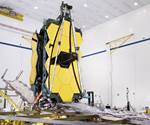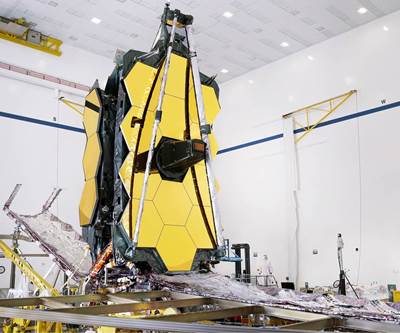Successful tower extension test for James Webb space telescope
The test ensured the tower extensions on NASA’s composites-intensive telescope would keep the structure cool enough to detect infrared light.

Technicians inspect a critical part of the James Webb Space Telescope known as the Deployable Tower Assembly after fully extending it in the same maneuver it will perform once in space. Source | Northrop Grumman
NASA (Washington, D.C., U.S.) announced on June 9 that it has successfully deployed and extended the Deployable Tower Assembly as part of the testing regime of the James Webb Space Telescope (JWST). NASA’s most complex, composites-intensive space telescope, JWST is designed to look for faint traces of infrared light coming from astronomical objects.
NASA says the Deployable Tower Assembly’s primary purpose is to create a large gap between the upper part of the observatory that houses its gold mirrors and scientific instruments, and the lower section known as the spacecraft bus, which holds its comparatively warm electronics and propulsion systems. By creating a space between the two, it allows for Webb’s active and passive cooling systems to bring its mirrors and sensors down to the cold temperatures required to perform properly.
During the test, the tower was slowly extended 48 inches (1.2 meters) upward over the course of several hours. Simulating the zero-gravity environment in which Webb will operate, engineers employed a series of pulleys, counterbalances and a gravity-negation system that offloaded the effects of Earth’s gravity on the structure.
“It performed as predicted, and from our expectations from previous tests before the full observatory was assembled,” says Alphonso Stewart the Webb deployment systems lead for NASA’s Goddard Space Flight Center in Greenbelt, Md., U.S. “This was the first time this part of Webb was tested in its flight-like configuration to the highest level of fidelity we possibly could. This test provides the opportunity to assess all interfaces and interactions between the instrument and bus sections of the observatory."
As the largest space science observatory built, NASA says engineers had to design JWST to fold into a much smaller configuration to fit inside an Ariane 5 rocket for launch. The Deployable Tower Assembly — in addition to helping the observatory cool down — allows Webb to just barely fit inside a 17.8-foot (5.4-meter) payload fairing. Once in space, the tower will extend to give the rest of Webb’s deployable parts, such as the sunshield and mirrors, the amount of room needed to unpack and unfold into a fully functional infrared space observatory.
“We need to know that Webb will work the way we expect it to before we send it to space,” notes Stewart. “This is why we test, and when we do, we test as flight-like as possible. The way we send the commands to the spacecraft, the sequence, the individual sitting at the console, the communication that we use. We replicate all of these things to see if we are missing something, to see if there is something that needs to be changed, and to make sure that all of our planning to date has been correct.”
Following augmented personal safety procedures due to COVID-19, JWST’s team in California continued integration and testing work with significantly reduced on-site personnel and shifts. The NASA/Northrop Grumman team recently resumed near-full operations. NASA is evaluating potential impacts on the March 2021 launch date and will assess the schedule and adjust decisions as the situation unfolds.
Related Content
Welding is not bonding
Discussion of the issues in our understanding of thermoplastic composite welded structures and certification of the latest materials and welding technologies for future airframes.
Read MorePlant tour: Teijin Carbon America Inc., Greenwood, S.C., U.S.
In 2018, Teijin broke ground on a facility that is reportedly the largest capacity carbon fiber line currently in existence. The line has been fully functional for nearly two years and has plenty of room for expansion.
Read MorePlant tour: Joby Aviation, Marina, Calif., U.S.
As the advanced air mobility market begins to take shape, market leader Joby Aviation works to industrialize composites manufacturing for its first-generation, composites-intensive, all-electric air taxi.
Read MoreComposites manufacturing for general aviation aircraft
General aviation, certified and experimental, has increasingly embraced composites over the decades, a path further driven by leveraged innovation in materials and processes and the evolving AAM market.
Read MoreRead Next
NASA assembles James Webb Telescope
NASA has successfully connected the two halves — the Optical Telescope Element (OTE) and the Space Craft Element (SCE) — of the composites intensive James Webb Telescope for the first time, marking a major milestone for the program.
Read MoreDeveloping bonded composite repair for ships, offshore units
Bureau Veritas and industry partners issue guidelines and pave the way for certification via StrengthBond Offshore project.
Read More“Structured air” TPS safeguards composite structures
Powered by an 85% air/15% pure polyimide aerogel, Blueshift’s novel material system protects structures during transient thermal events from -200°C to beyond 2400°C for rockets, battery boxes and more.
Read More

















.jpg;maxWidth=300;quality=90)








